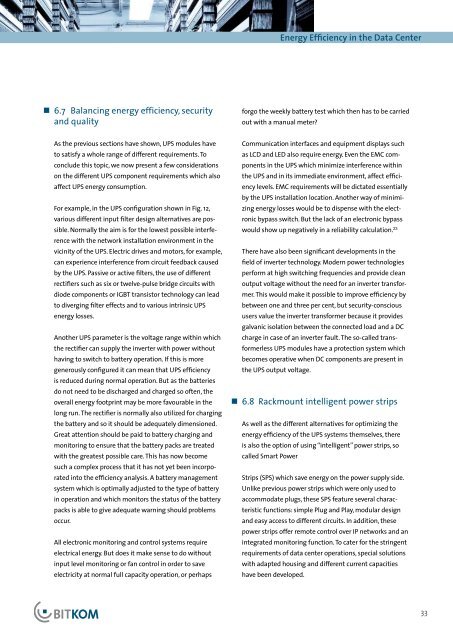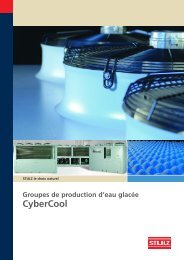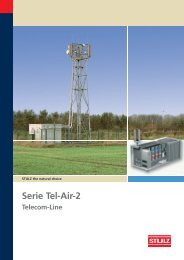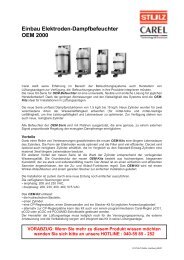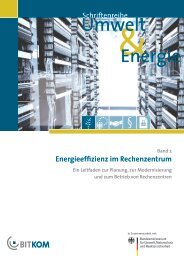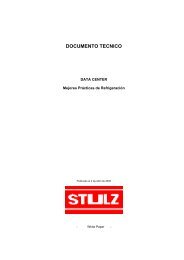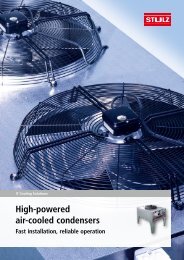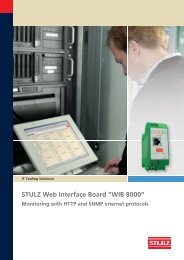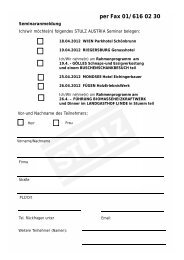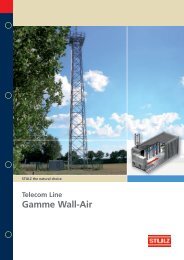Climate protection needs energy efficient data centers - Stulz GmbH
Climate protection needs energy efficient data centers - Stulz GmbH
Climate protection needs energy efficient data centers - Stulz GmbH
You also want an ePaper? Increase the reach of your titles
YUMPU automatically turns print PDFs into web optimized ePapers that Google loves.
Energy Efficiency in the Data Center• 6.7 Balancing <strong>energy</strong> efficiency, securityand qualityforgo the weekly battery test which then has to be carriedout with a manual meter?As the previous sections have shown, UPS modules haveto satisfy a whole range of different requirements. Toconclude this topic, we now present a few considerationson the different UPS component requirements which alsoaffect UPS <strong>energy</strong> consumption.For example, in the UPS configuration shown in Fig. 12,various different input filter design alternatives are possible.Normally the aim is for the lowest possible interferencewith the network installation environment in thevicinity of the UPS. Electric drives and motors, for example,can experience interference from circuit feedback causedby the UPS. Passive or active filters, the use of differentrectifiers such as six or twelve-pulse bridge circuits withdiode components or IGBT transistor technology can leadto diverging filter effects and to various intrinsic UPS<strong>energy</strong> losses.Another UPS parameter is the voltage range within whichthe rectifier can supply the inverter with power withouthaving to switch to battery operation. If this is moregenerously configured it can mean that UPS efficiencyis reduced during normal operation. But as the batteriesdo not need to be discharged and charged so often, theoverall <strong>energy</strong> footprint may be more favourable in thelong run. The rectifier is normally also utilized for chargingthe battery and so it should be adequately dimensioned.Great attention should be paid to battery charging andmonitoring to ensure that the battery packs are treatedwith the greatest possible care. This has now becomesuch a complex process that it has not yet been incorporatedinto the efficiency analysis. A battery managementsystem which is optimally adjusted to the type of batteryin operation and which monitors the status of the batterypacks is able to give adequate warning should problemsoccur.All electronic monitoring and control systems requireelectrical <strong>energy</strong>. But does it make sense to do withoutinput level monitoring or fan control in order to saveelectricity at normal full capacity operation, or perhapsCommunication interfaces and equipment displays suchas LCD and LED also require <strong>energy</strong>. Even the EMC componentsin the UPS which minimize interference withinthe UPS and in its immediate environment, affect efficiencylevels. EMC requirements will be dictated essentiallyby the UPS installation location. Another way of minimizing<strong>energy</strong> losses would be to dispense with the electronicbypass switch. But the lack of an electronic bypasswould show up negatively in a reliability calculation. 23There have also been significant developments in thefield of inverter technology. Modern power technologiesperform at high switching frequencies and provide cleanoutput voltage without the need for an inverter transformer.This would make it possible to improve efficiency bybetween one and three per cent, but security-conscioususers value the inverter transformer because it providesgalvanic isolation between the connected load and a DCcharge in case of an inverter fault. The so-called transformerlessUPS modules have a <strong>protection</strong> system whichbecomes operative when DC components are present inthe UPS output voltage.• 6.8 Rackmount intelligent power stripsAs well as the different alternatives for optimizing the<strong>energy</strong> efficiency of the UPS systems themselves, thereis also the option of using “intelligent” power strips, socalled Smart PowerStrips (SPS) which save <strong>energy</strong> on the power supply side.Unlike previous power strips which were only used toaccommodate plugs, these SPS feature several characteristicfunctions: simple Plug and Play, modular designand easy access to different circuits. In addition, thesepower strips offer remote control over IP networks and anintegrated monitoring function. To cater for the stringentrequirements of <strong>data</strong> center operations, special solutionswith adapted housing and different current capacitieshave been developed.33


